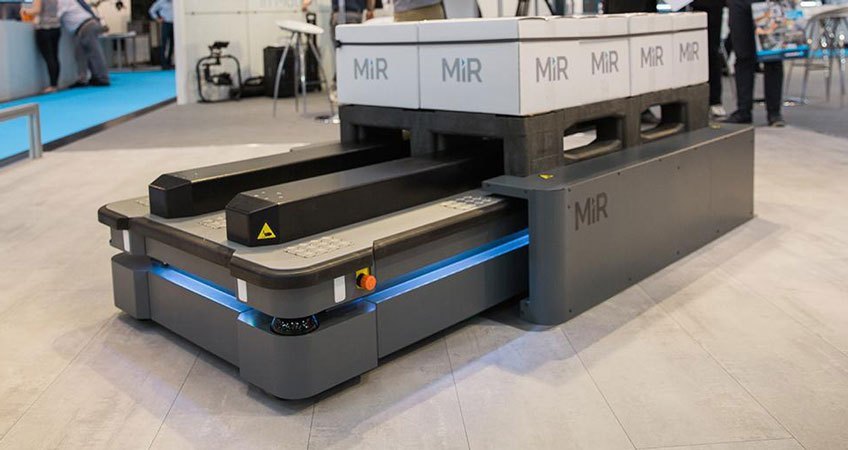Venture capitalists have invested $313 million in autonomous mobile robots for use in production and labor processes in the past several years.
American manufacturing is evolving, and autonomous robots have arrived on the assembly line. But is this really a good thing? Is this something we should be moving toward?
The short answer is yes.
Here are nine benefits of having autonomous mobile robots as part of your team.
Increased Flexibility
Autonomous mobile robots rely largely on onboard sensors and cameras to operate. This is different than previous generations of robots, which relied on wires or magnetic tape.
This change means that autonomous mobile robots are able to produce flexible, agile automation. Instead of having to follow the same, hard-set path every time, autonomous mobile robots are able to create their own pathway within a facility. By doing so, they’re able to get from Point A to Point B while avoiding obstacles.
This also means that autonomous mobile robots are able to be switched to performing new tasks easily and quickly. They don’t require as much time to reprogram as older generations of robots.
Increased Safety
Autonomous mobile robots don’t just have onboard sensors and cameras, they have a ton of onboard sensors and cameras. These allow the robots to take in, interpret, and understand their environment. And this allows the robots to travel through the facility or warehouse without running into things like people, products, or infrastructure.
Equipment run by human engineers, such as forklifts, don’t have as many built-in safety mechanisms. They ultimately rely on human input.
Human operators always have the potential of becoming distracted or tired, leading to error or accidents. Robots, on the other hand, never become distracted or tired. They’re always on top of their game.
This drastically improves the overall safety of your facility.
Quick Implementation
Autonomous mobile robots can be integrated into your operation within four to six weeks. The actual time varies based on the specifics of your operation and the software that your robot has to work with.
This is a very small amount of time to integrate something new into your operation. As a point of comparison, a goods-to-person system can take up to a whole year to fully implement and get working correctly.
Easy to Integrate
Autonomous mobile robots are surprisingly easy to integrate into any facility. All you need to really provide the autonomous robot with is a map of the facility. This is how the robot is able to move around the facility and complete the jobs you’ve assigned to it.
This ability to integrate the robots easily means you don’t need to set up dedicated paths, install anything on the floor, or restrict humans and forklifts from operating in areas where robots are being used.
Once the robots have a map of your warehouse, which can be done in a day or two by a single person, they can use their sensors and onboard cameras to do the rest.
Ability to Scale
Because autonomous mobile robots are so easy to integrate and implement in your facility, it’s easy to start out with just a few units and then add more as your operation grows or changes.
You can increase or decrease the scale of your robots as necessary.
This is great because it decreases your initial investment. How? Because instead of purchasing an entire fleet of robots at once, you can start out with a few and gradually increase your stock.
This frees up your money to use on other investments and experiments while giving you time to analyze how the robots work within your organization to decide if you want to implement more.
Easy to Move Between Facilities
Before, with the old robots, it was discouraging to think about adding them to your operation if you knew you were possibly moving to a new facility in the future. Which makes sense. Why implement a new system that will have to be taken apart and rebuilt in the next year or two?
However, with the new autonomous mobile robots, they’re so easy to implement and deploy that they’re easy to move between facilities. All you need is a new map and a little bit of work and boom! Your system is up and running again.
Autonomous Robots Work Well with a High Number of SKUs
Autonomous robots work to make your operation more efficient by reducing travel time. What does this mean? Well, the less time an employee spends traveling, the more time they are spending in their zone of the warehouse picking and fulfilling orders.
The good news is that autonomous robots work really well with a high number of SKUs. This is because the more SKUs that are on hand the more travel time that is spent fulfilling an order.
So the robots are able to cut down on a lot of employee travel time. The more SKUs there are, the more travel time is cut down.
Robots are Identical
All of the autonomous robots react the same way to the same commands. There is no worrying about differing quality in work product or accounting for the different ways employees do their jobs. Robots do the same thing every time.
And they all do it the same way as each other.
This helps to improve workplace consistency and productivity.
Robots Are Constantly Improving
There is research going on all the time to improve robotics software and hardware. This means your robots are constantly improving the way they do their jobs.
And the more they improve their jobs, the more your workplace productivity improves.
Final Thoughts
Now that you know why you should have autonomous robots as part of your team, are you ready to take the plunge? If so, we can help with that!
Feel free to contact us to set up a consultation or ask any questions you may have. We can provide systems tailored to suit your specific application needs.

Recent Comments